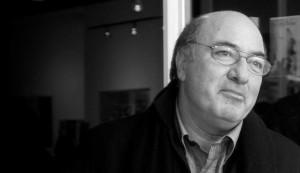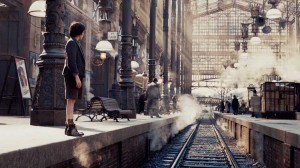
I’ve read that growing up in the small town of Macerata, Italy, in the 1950s, Dante Ferretti spent a lot of time in movie theaters watching Ben Hur, Cleopatra and spaghetti Westerns.
So it’s with visions of a Cinema Paradiso childhood that my first question for the master designer is, “When you were young…”
“I’m still young,” he snaps. Then he laughs.
Of course, forget the fact that he’s credited as production designer in about 60 films, or that he turns 69 next month. It would take someone who can see with the eyes of a boy to design the world of wonder that Ferretti has in Hugo.
Next, I ask, “In Hugo, the train station…”
“Not just the train station,” he snaps. Then he laughs. The train station with its huge open spaces full of travelers, and its high ceilings, based on the great European train stations of the past, has received so much attention that he sounds a little peeved the other spaces he designed for the movie have, by comparison, been slighted. “Also the terminals,” he says, “the secret apartment, Georges Melies’s apartment, the graveyard, everything. All of Paris!” he says, and laughs.
Actually, all of Paris out the window of the train station he credits to the visual effects team led by Rob Legato.
The mention of Legato makes me wonder, and I ask, “Do you ever use a computer?”

“Never!” he says in his trademark Italian accent. “I make sketches. The other people that work with me, they use computers. But I like to design with my hand. It is difficult to tell anyone what you have in mind, but you can do it after you make sketches. I make very big sketches.”
Ferretti began his career working on Italian films with Pier Paolo Pasolini and then Federico Fellini. His first film with director Martin Scorcese – Hugo is their eighth – was The Age of Innocence (1993). It’s an image from a filmmaking textbook, imagining Scorcese and Ferretti plotting what a film will look like.
I ask, “Do you and Scorcese ever speak in Italian?”
“Never. I speak in English to Martin. My English is very bad but I did eight movies with Martin,” he says. “Martin speaks very fast but we understand each other very well. He talks in movies. He wants you to see something, one scene, two scenes… he makes me watch a whole movie.”
“What does it feel like to win an Oscar?” I ask. “Not bad,” he laughs. “Because after six times I did not believe I would.”
Indeed, Ferretti was nominated six times for art direction and once for best costume designer. On Kundun, also directed by Scorcese.
Though he had given up hope of ever winning, he was nominated again in 2005 for Scorcese’s Howard Hughes biopic, The Aviator. He won that year and again three years later for Sweeny Todd: the Demon Barber of Fleet Street, directed by Tim Burton. Both those awards, and most of his nominations, he has shared with his wife, the set decorator, Francesca Lo Schiavo. He credits her with another amazing job as the set decorator on Hugo, including supervising a team that built all the toys in the train station’s toy shop, and putting almost 40,000 books inside the book shop.
Ferretti’s next project will also be directed by Scorcese. It is Silence – the 17th century story of two Jesuit priests traveling to Japan, starring Daniel Day-Lewis, Benicio del Toro and Gabriel Garcia Bernal.





